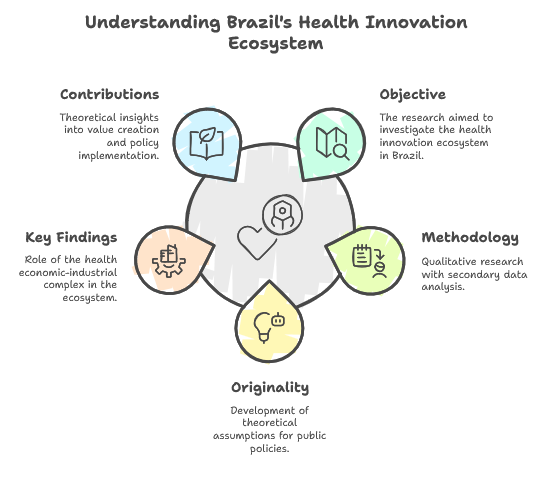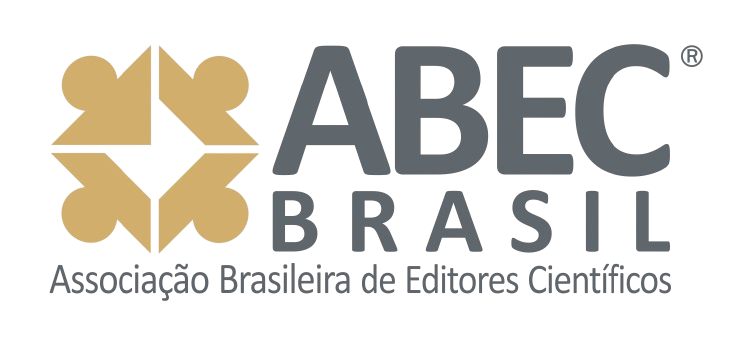Innovation Ecosystem: Research in the brazilian health sector
DOI:
https://doi.org/10.24883/eagleSustainable.v14i.470Keywords:
Innovation ecosystem, Innovation ecosystem in Health, Health economic-industrial complexAbstract
Objective: The research aimed to investigate the health innovation ecosystem (EIS) in Brazil.
Methodology/Approach: Qualitative research, with secondary data collection and data analysis through content in light of the theory on innovation ecosystems.
Originality/Relevance: Development of theoretical assumptions that guide the discussion of public policies seeking to overcome the challenges, present in financing, scalability, incorporation and adoption of technologies.
Key Findings: Promoted by the National Policy for Technological Innovation in Health (PNITS), the health economic-industrial complex (CEIS) plays a fundamental role in the health sector, in structuring characteristics inherent to an ecosystem, as well as the conditions that converge to a higher level of interactions between the actors.
Theoretical/Methodological Contributions: The research contributes, theoretically, by elucidating the relationships of value creation in the EIS and its potential for solving social and health problems, through the implementation of cross-cutting public policies that contemplate the diversity of actors.
Downloads
References
Adner, R. (2017) Ecosystem as Structure: An Actionable Construct for Strategy. Journal of Management, 43(1), 39–58. https://doi.org/10.1177/0149206316678451 DOI: https://doi.org/10.1177/0149206316678451
Adner, R. & Kapoor, R. (2010). Value creation in innovation ecosystems: how the structure of technological interdependence affects firm performance in new technology generations. Strategic Management Journal, 31(3), 306–333. https://doi.org/10.1002/smj.821 DOI: https://doi.org/10.1002/smj.821
Autio, E. (1998). Evaluation of RTD in regional systems of innovation. European Planning Studies, 6(2), 131–140. https://doi.org/10.1080/0965431980872045 DOI: https://doi.org/10.1080/09654319808720451
Autio, E., & Thomas, L. D. W. (2014). Innovation ecosystems: Implications for innovation management. In M. Dodgson, D. M. Gann, & N. Phillips (Eds.), The Oxford handbook of innovation management (pp. 204-228). Oxford: Oxford University Press. DOI: https://doi.org/10.1093/oxfordhb/9780199694945.013.012
Autio, E., & Thomas, L. D. W. (2018). Tilting the playing field: Towards an endogenous strategic action theory of ecosystem creation. In S. Nambisan (Ed.), Open innovation, ecosystems and entrepreneurship: Issues and perspectives (pp. 111-140). New Jersey, NJ: World Scientific Publishing. DOI: https://doi.org/10.1142/9789813149083_0005
Autio, E. and Thomas, L.D.W. (2022), "Researching ecosystems in innovation contexts", Innovation & Management Review, Vol. 19 No. 1, pp. 12-25. https://doi.org/10.1108/INMR-08-2021-0151 DOI: https://doi.org/10.1108/INMR-08-2021-0151
Baldwin, Carliss Y. ( 2015). Bottlenecks, Modules and Dynamic Architectural Capabilities. Harvard Business School Finance Working Paper No. 15-028. http://dx.doi.org/10.2139/ssrn.2512209 DOI: https://doi.org/10.2139/ssrn.2512209
Barros, A. J. S. & Lehfeld, N. A. S. (2007). Fundamentos de metodologia científica. 3. ed. São Paulo: Pearson Prentice Hall.
Basole R. C. & Rouse W.C., (2008). Complexity of service value networks: Conceptualization and empirical investigation, in IBM Systems Journal, 47 (1,) 53-70, 200https://doi.org/10.1147/sj.471.0053 DOI: https://doi.org/10.1147/sj.471.0053
Blau, P. M. (1986). Exchange and power in social life. Piscataway. NJ: Transaction Publishers. https://doi.org/10.4324/9780203792643 DOI: https://doi.org/10.4324/9780203792643
Brasil. (2016). Lei nº 13.243, de 11 de janeiro de 2016. Disponível em: https://www.planalto.gov.br/ccivil_03/_Ato2015-2018/2016/Lei/L13243.htm
Burgelman, R. A. (1991). Intraorganizational Ecology of Strategy Making and Organizational Adaptation: Theory and Field Research. Organization Science, 2(3), 239–262. http://www.jstor.org/stable/2634929 DOI: https://doi.org/10.1287/orsc.2.3.239
Cai, Y., Lattu, A. (2022). Triple Helix or Quadruple Helix: Which Model of Innovation to Choose for Empirical Studies?. Minerva 60, 257–280. https://doi.org/10.1007/s11024-021-09453-6 DOI: https://doi.org/10.1007/s11024-021-09453-6
Cao, Z. & Thomas, L. (2021). Ecosystem Benefits: An Integrative Framework. Academy of Management Proceedings. 2021. 16405. https://doi.org/10.5465/AMBPP.2021.16405abstract DOI: https://doi.org/10.5465/AMBPP.2021.16405abstract
Carayannis, E.G., Barth, T.D. & Campbell, D.F. (2012). The Quintuple Helix innovation model: global warming as a challenge and driver for innovation. J Innov Entrep 1, 2. https://doi.org/10.1186/2192-5372-1-2 DOI: https://doi.org/10.1186/2192-5372-1-2
Carayannis, E. G., & Campbell, D. F. J. (2006). Knowledge creation, diffusion, and use in innovation networks and knowledge clusters: a comparative systems approach across the United States, Europe, and Asia. Praeger Publishers, Westport, CT. DOI: https://doi.org/10.5040/9798400675959
Cavalcanti, I. T. do N., Ferreira Júnior, H. de M., Amorim, I. R. de, & Fraga, J. A. (2020). Complexo econômico industrial de saúde: uma análise da situação brasileira. Nexos Econômicos, 12(2), 8–30. https://doi.org/10.9771/rene.v12i2.34121 DOI: https://doi.org/10.9771/rene.v12i2.34121
Cooper, D. R. & Schindler, P. S. (2016). Métodos de Pesquisa em Administração-12a edição. [s.l.] McGraw Hill Brasil.
De Moura Filho, S. L. et al. (2019). Universidade empreendedora–um método de avaliação e planejamento aplicado no Brasil. Revista Gestão & Tecnologia, 19(1), 159-184. https://doi.org/10.20397/2177-6652/2019.v19i1.1514 DOI: https://doi.org/10.20397/2177-6652/2019.v19i1.1514
Domanski, D., Howaldt, J., & Kaletka, C. (2019). A comprehensive concept of social innovation and its implications for the local context – on the growing importance of social innovation ecosystems and infrastructures. European Planning Studies, 28(3), 454–474. https://doi.org/10.1080/09654313.2019.1639397 DOI: https://doi.org/10.1080/09654313.2019.1639397
Etzkowitz, H., & Zhou, C. (2017). Hélice Tríplice: inovação e empreendedorismo universidade-indústria-governo. Estudos Avançados, 31(90), 23–48. https://doi.org/10.1590/s0103-40142017.3190003 DOI: https://doi.org/10.1590/s0103-40142017.3190003
Eurico Soares de Noronha, M., Barros Neves Martins, J., Lietti, T., & de Souza Vieira Silva, R. (2022). Organizational Agility And the Diffusion of Technological Innovation In Cleantech Companies. Journal of Sustainable Competitive Intelligence, 12(1), e0412. https://doi.org/10.24883/IberoamericanIC.v12i.2022.e0412 DOI: https://doi.org/10.24883/IberoamericanIC.v12i.2022.e0412
Felipe, M. S. S., Rezende, K. S., Rosa, M. F. F., & Gadelha, C. A. G.. (2019). Um olhar sobre o Complexo Econômico Industrial da Saúde e a Pesquisa Translacional. Saúde Em Debate, 43(123), 1181–1193. https://doi.org/10.1590/0103-1104201912316 DOI: https://doi.org/10.1590/0103-1104201912316
Flick, U. (2009). Introdução à pesquisa qualitativa-3. [s.l.] Artmed editora.
Gadelha, C. A. G.. (2003). O complexo industrial da saúde e a necessidade de um enfoque dinâmico na economia da saúde. Ciência & Saúde Coletiva, 8(2), 521–535. https://doi.org/10.1590/S1413-81232003000200015 DOI: https://doi.org/10.1590/S1413-81232003000200015
Gomes, L. A. DE V. et al. (2018) Unpacking the innovation ecosystem construct: Evolution, gaps and trends. Technological Forecasting and Social Change, 136, 30–48. https://doi.org/10.1016/j.techfore.2016.11.009 DOI: https://doi.org/10.1016/j.techfore.2016.11.009
Gomes, L. A. DE V. et al. (2021). Ecosystem management: Past achievements and future promises. Technological Forecasting and Social Change, 171, 120950. https://doi.org/10.1016/j.techfore.2021.120950 DOI: https://doi.org/10.1016/j.techfore.2021.120950
Gulati, R., Puranam, P. & Tushman, M. (2012), Meta-organization design: Rethinking design in interorganizational and community contexts. Strat. Mgmt. J., 33: 571-586. https://doi.org/10.1002/smj.1975 DOI: https://doi.org/10.1002/smj.1975
Howaldt, J., Kopp, R., & Schwarz, M. (2015). On the theory of social innovations: Tarde's neglected contribution to the development of a sociological innovation theory. Weinheim, DE: Beltz Juventa. https://www.ssoar.info/ssoar/handle/document/41963
International Development Innovation Alliance. (2021). Strengthening Innovation Ecosystems. Disponível em: https://static1.squarespace.com/static/6295f2360cd56b026c257790/t/62a1cd5ed04abc2aac8c4880/1654771043557/Strengthening%2BInnovation%2BEcosystems+English.pdf
Jacobides, M. G., Cennamo, C., & Gawer, A. (2018). Towards a theory of ecosystems. Strategic Management Journal, 39(8), 2255–2276. https://doi.org/10.1002/smj.2904 DOI: https://doi.org/10.1002/smj.2904
Kapoor, R. & Lee, J. M. (2013). Coordinating and competing in ecosystems: How organizational forms shape new technology investments. Strategic Management Journal, 4(3) 274–296. https://doi.org/10.1002/smj.2010 DOI: https://doi.org/10.1002/smj.2010
Kon, A. (2016). Ecossistemas de inovação: a natureza da inovação em serviços. Revista de Administração, Contabilidade e Economia da Fundace. 7. https://doi.org/10.13059/racef.v7i1.170 DOI: https://doi.org/10.13059/racef.v7i1.170
Leten, B., Vanhaverbeke, W., Roijakkers, N., Clerix, A., & Van Helleputte, J. (2013). IP Models to Orchestrate Innovation Ecosystems: IMEC, a Public Research Institute in Nano-Electronics. California Management Review, 55(4), 51-64. https://doi.org/10.1525/cmr.2013.55.4.51 DOI: https://doi.org/10.1525/cmr.2013.55.4.51
Leydesdorff L. & Ivanova I. (2021). The measurement of “interdisciplinarity” and “synergy” in scientific and extra-scientific collaborations. Journal of the Association for Information Science and Technology. 72: 387–402. https://doi.org/10.1002/asi.24416 DOI: https://doi.org/10.1002/asi.24416
Lusch, R. F., & Nambisan, S. (2015). Service innovation: a service-dominant logic perspective. MIS Q. 39(1) (March 2015), 155–176. https://doi.org/10.25300/MISQ/2015/39.1.07
Merriam, S. B. & Tisdell, E. J. (2015). Qualitative research: A guide to design and implementation. [s.l.] John Wiley & Sons.
Moore, J. Predators and prey: a new ecology of competition. Harvard business review, v. 71, n. 3, p. 75–86, 1993.
Moore, J. (2006). Business ecosystems and the view of the firm. The Antitrust Bulletin. 51. https://doi.org/10.1177/0003603X0605100103 DOI: https://doi.org/10.1177/0003603X0605100103
OECD (2023), Health at a Glance 2023: OECD Indicators, OECD Publishing, Paris, https://doi.org/10.1787/7a7afb35-en. DOI: https://doi.org/10.1787/7a7afb35-en
Overholm, H. (2014). Collectively created opportunities in emerging ecosystems: The case of solar service ventures. Technovation. 39-40. https://doi.org/10.1016/j.technovation.2014.01.008 DOI: https://doi.org/10.1016/j.technovation.2014.01.008
Polese, F.; Botti, A.; Grimaldi, M.; Monda, A.; Vesci, M. (2018). Social Innovation in Smart Tourism Ecosystems: How Technology and Institutions Shape Sustainable Value Co-Creation. Sustainability 10 (140). https://doi.org/10.3390/su10010140 DOI: https://doi.org/10.3390/su10010140
Priem, R. L., Butler, J. E., & Li, S. (2013). Toward reimagining strategy research: retrospection and prospection on the 2011 amr decade award article. The Academy of Management Review, 38(4), 471–489. http://www.jstor.org/stable/43699220 DOI: https://doi.org/10.5465/amr.2013.0097
Ritala, P., Agouridas, F., Assimakopoulos, D. & Gies, O. (2013) Value creation and capture mechanisms in innovation ecosystems: a comparative case study. International Journal of Technology Management, 64(3/4), 244. https://doi.org/10.1504/IJTM.2013.056900 DOI: https://doi.org/10.1504/IJTM.2013.056900
Schau, H. J., Muniz, Jr, A. M., & Arnould, E. J. (2009). How brand community practices create value. Journal of Marketing, 73(5), 30-51. https://doi.org/10.1509/jmkg.73.5.30 DOI: https://doi.org/10.1509/jmkg.73.5.30
Shaw, D. R. & Allen, T. (2018) Studying innovation ecosystems using ecology theory. Technological Forecasting and Social Change, 136, 88–102. https://doi.org/10.1016/j.techfore.2016.11.030 DOI: https://doi.org/10.1016/j.techfore.2016.11.030
Simon, H. A. (1962). The architecture of complexity. Proceedings of the American philosophical society, 106(6), 467–482.
Teece D. J. (2018). Business ecosystem. In: Augier M., Teece D. J., eds. The Palgrave encyclopedia of strategic management. London: Palgrave Macmillan UK, 151–154. https://doi.org/10.1057/978-1-137-00772-8_724 DOI: https://doi.org/10.1057/978-1-137-00772-8_724
Tautz, J., Heilmann, H. R., & Sandeman, D. (2008). The buzz about bees: biology of a superorganism. [s.l.] Springer. DOI: https://doi.org/10.1007/978-3-540-78729-7
Thomas, L.& Autio, E. (2012) Modeling the ecosystem: a meta-synthesis of ecosystem and related literatures. DRUID 2012 Conference, Copenhagen (Denmark).
Thomas, L. & Autio, E. Innovation Ecosystems (2019), http://dx.doi.org/10.2139/ssrn.3476925 DOI: https://doi.org/10.2139/ssrn.3476925
Trudgill, S. (2007). Tansley, A.G. 1935: The use and abuse of vegetational concepts and terms. Ecology 16, 284—307. Progress in Physical Geography: Earth and Environment, 31(5), 517-522. https://doi.org/10.1177/0309133307083297 DOI: https://doi.org/10.1177/0309133307083297
Torlig, E., Resende Junior, P. C., Fujihara, R. K., & Montezano, L. (2020). Framework Integrativo de Inovação Social Colaborativa a Partir do Projeto Rondon. Desenvolvimento Em Questão, 18(53), 330–351. https://doi.org/10.21527/2237-6453.2020.53.330-351 DOI: https://doi.org/10.21527/2237-6453.2020.53.330-351
Valkokari, K. (2015). Business, innovation, and knowledge ecosystems: How they differ and how to survive and thrive within them. Technology Innovation Management Review (TIM Review), 5(8), 17-24. http://timreview.ca/article/919 DOI: https://doi.org/10.22215/timreview/919
Virgilio Panapanaan , Tuomo Uotila & Anne Jalkala (2013): Creation and Alignment of the Eco-innovation Strategy Model to Regional Innovation Strategy: A Case from Lahti (Päijät-Häme Region), Finland, European Planning Studies, https://doi.org/10.1080/09654313.2013.774322 DOI: https://doi.org/10.1080/09654313.2013.774322
West, J., & Wood, D. (2014). Evolving an Open Ecosystem: The Rise and Fall of the Symbian Platform, Collaboration and Competition in Business, 30, 27-67. https://doi.org/10.1108/S0742-3322(2013)0000030005 DOI: https://doi.org/10.1108/S0742-3322(2013)0000030005
WHO (2024). Global Health Expenditure Database, WHO, https://apps.who.int/nha/database/country_profile/Index/en.

Downloads
Published
How to Cite
Issue
Section
License
Copyright (c) 2024 Journal of Sustainable Competitive Intelligence

This work is licensed under a Creative Commons Attribution 4.0 International License.
Authors who publish with this journal agree to the following terms:
1. Authors who publish in this journal agree to the following terms: the author(s) authorize(s) the publication of the text in the journal;
2. The author(s) ensure(s) that the contribution is original and unpublished and that it is not in the process of evaluation by another journal;
3. The journal is not responsible for the views, ideas and concepts presented in articles, and these are the sole responsibility of the author(s);
4. The publishers reserve the right to make textual adjustments and adapt texts to meet with publication standards.
5. Authors retain copyright and grant the journal the right to first publication, with the work simultaneously licensed under the Creative Commons Atribuição NãoComercial 4.0 internacional, which allows the work to be shared with recognized authorship and initial publication in this journal.
6. Authors are allowed to assume additional contracts separately, for non-exclusive distribution of the version of the work published in this journal (e.g. publish in institutional repository or as a book chapter), with recognition of authorship and initial publication in this journal.
7. Authors are allowed and are encouraged to publish and distribute their work online (e.g. in institutional repositories or on a personal web page) at any point before or during the editorial process, as this can generate positive effects, as well as increase the impact and citations of the published work (see the effect of Free Access) at http://opcit.eprints.org/oacitation-biblio.html
• 8. Authors are able to use ORCID is a system of identification for authors. An ORCID identifier is unique to an individual and acts as a persistent digital identifier to ensure that authors (particularly those with relatively common names) can be distinguished and their work properly attributed.












